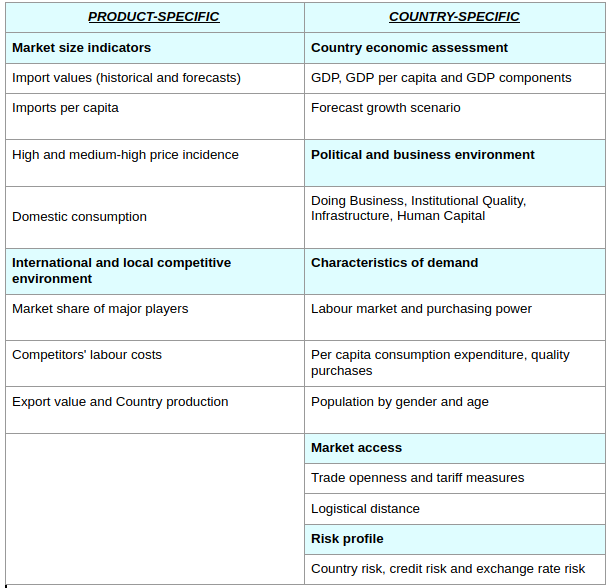ExportPlanning Market Selection: a User Guide
ExportPlanning's indicators of opportunity, reliability and accessibility for an effective market selection
Published by Marzia Moccia. .
Planning Bestpractice Marketselection Export markets International marketing Internationalisation tools
Log in to use the pretty print function and embed function.
Aren't you signed up yet?
signup!
Within an internationalisation process, the choice of target market is a complex decision. It represents one of the most delicate moments in the definition of the export strategy. Its primary objective is to identify the market with the best risk/opportunity profile, taking into account the specific characteristics of a company. In a best practice approach, the market selection phase can be summarised in three fundamental steps:
- construction of a wide information set able to fill the gap resulting from a lack of direct experience of the company in the new market;
- systematisation and benchmarking of various market indicators collected;
- matching of the market potential indicators on the basis of the company's strengths and weaknesses and strategic objectives.
The Market Selection module of ExportPlanning is dedicated to efficiently providing the appropriate analytical tools when assessing and selecting a new market, through the collection, comparison and weighting of a robust basket of information on risks and opportunities.
The relevance of data and the construction of a broad information set
The essential starting point is the systematisation of objective, certified and robust data that can effectively summarise the profile of possible target markets.
According to ExportPlanning's experience, when selecting a new market, there are several indicators to take into account. The number of indicators that the tool allows to select is actually very large; they refer to different macro-fields of analysis, as summarised in the table below.
ExportPlanning indicators

First, it is possible to sub-divide ExportPlanning indicators into product-specific and country-specific indicators: the former allow for detailed analysis at the product level, thus introducing information specific to the sector of interest; the latter, on the other hand, are macroeconomic indicators of a 'transversal' nature, relating to the country and invariant to the product dimension.
From a strategic point of view, it is possible to segment the range of indicators available in ExportPlanning into three main macro-categories: opportunity, reliability and accessibility. This categorisation makes it easier to identify the most effective set of indicators for your request.
Which indicators to choose and which information to prioritise?
There is no unequivocal answer to this question, since the selection of the basket of information is often strongly dependent on the specific characteristics of a company and of a product/sector. However, in order to provide some useful advice, for each of the three areas previously identified, a selection of particularly effective indicators is presented below.
- When assessing market opportunities, it is important to include indicators that allow for a direct and robust measure of the market size per country, such as the import value of the product and forecasts. In addition, it is often highly informative to include data on the country's exports and production in the end-user segments, especially if you consider the customs code to be unrepresentative of your product.
It is also good practice to combine sectoral opportunity indicators with macroeconomic indicators that express the current and prospective state of the economy (expected GDP growth). - When qualifying a market in terms of reliability, it is necessary to systematise the different risk elements that insist on the country profile, such as political-normative risk, exchange rate risk and sovereign and corporate default risk. A particularly informative synthetic indicator for this activity is Coface's Country risk assessment (Macroeconomic Indicators -> Country Risk).
- In assessing market accessibility, the ExportPlanning indicators of Business Distance and Geography are very in effectively in identifying the differences in logistical-distribution that exist between a country of reference and the market possibilities.
Comparative reading and definition of the weighting of the indicators
Once the basket of indicators has been defined, the identification of a ranking of markets with high potential arises from the construction of a matrix that allows a comparative reading of the information collected, in order to identify the priority countries as those characterised by the best opportunity/reliability/accessibility profile. The ranking of markets with the highest potential cannot be separated from an assessment of the company's actual ability to turn the internationalisation process into a moment of growth and development. It is therefore important to give the indicators of opportunity, reliability and market accessibility a weight according to the characteristics of the company itself. If, for example, the company's resources are limited, the market reliability indicators will have an increasingly important weight in the definition of the ranking.


